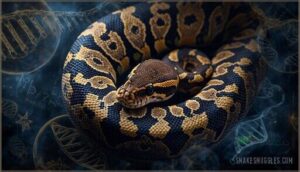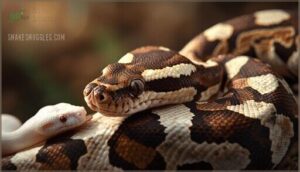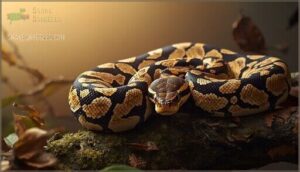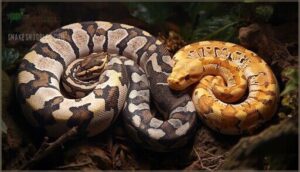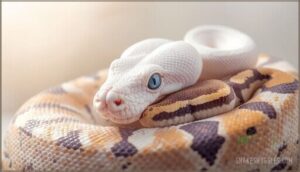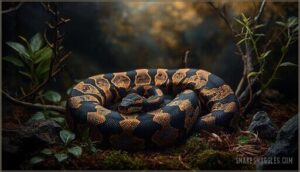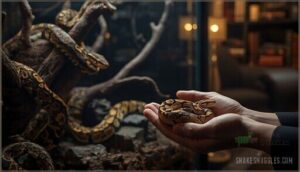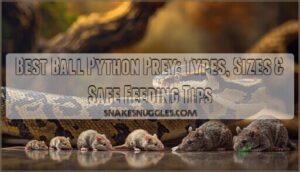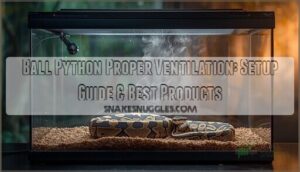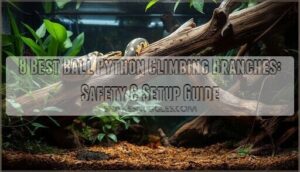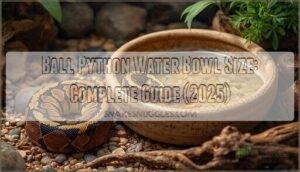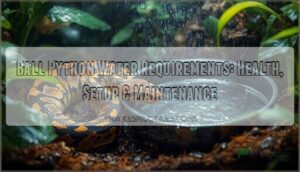This site is supported by our readers. We may earn a commission, at no cost to you, if you purchase through links.
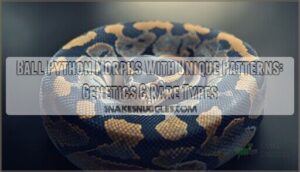
Over 6,000 documented genetic variations have emerged since breeders first isolated the recessive Piebald gene in the 1990s, transforming ball pythons from a single wild phenotype into a living canvas of pattern experimentation. These ball python morphs with unique patterns don’t just look different—they represent decades of strategic gene pairing, with some combinations commanding five-figure price tags and waiting lists that stretch for years.
Understanding what drives these pattern disruptions means diving into the mechanics of pigment suppression, dominant alleles, and the breeding strategies that turn genetic anomalies into reproducible designer morphs.
Table Of Contents
Key Takeaways
- Ball python morphs represent over 6,000 documented genetic variations created through strategic breeding of recessive, dominant, and co-dominant traits that control pigmentation and pattern expression, with some designer combinations commanding five-figure prices due to genetic complexity and rarity.
- Pattern mutations like Piebald (white patches from disrupted melanocyte migration), Spider (web-like striping with serious wobble syndrome), and Clown (jigsaw puzzle patterns) follow predictable Mendelian inheritance, allowing breeders to use Punnett squares and genetic testing to forecast offspring ratios before pairing snakes.
- Multi-gene designer morphs now represent 35% of high-end breeding programs, but stacking three or more genes increases genetic disorder risks by 10-15% without proper screening, making ethical breeding practices and health verification critical when pursuing rare combinations.
- Morph pricing reflects genetic complexity and market saturation—single-gene variants cost $100-$300 while newly discovered morphs debut above $10,000 but typically drop 60-80% within five years, with breeders who document lineage and avoid neurological morphs commanding 20-40% premiums for responsible practices.
What Are Ball Python Morphs?
Ball python morphs aren’t just variations—they’re living proof that selective breeding can transform a single species into thousands of distinct genetic masterpieces. Each morph represents specific mutations that alter pigmentation, pattern, and even scale structure, separating them from the wild-type ancestor that once roamed West African forests.
Understanding what defines a morph, how these snakes diverge from their natural counterparts, and why they’ve revolutionized reptile keeping will help you navigate this complex and rewarding field.
Definition and Overview of Morphs
Ball python morphs represent inherited genetic mutations that produce distinct variations in coloration and pattern expression, differing from the wild type. You’re looking at over 6,000 documented genetic variations in ball pythons, each showcasing unique patterns through color genetics and morph classification.
This morph diversity stems from natural polymorphisms and selective breeding practices that amplify specific traits, giving you unmatched control over pattern expression and genetic variation in your breeding projects.
Understanding the basics of ball python genetics is essential for breeders to create new and exotic morphs.
How Morphs Differ From Wild Type
Wild type ball pythons display a brown-and-black mottled pattern with irregular “alien head” shapes and faded gold dorsal striping—your genetic baseline. Morphs shatter this template through trait inheritance, producing pattern expression and color morphism that wild populations never exhibit.
Genetic variation in ball pythons creates white patches in Piebalds, eliminates melanin entirely in Albinos, and transforms mottled backgrounds into continuous dorsal stripes in Clowns. You’re witnessing morph classification driven by mutations in TYR, TYRP1, and OCA2 genes, allowing morph identification through unique patterns that give you remarkable control over genetic variations in ball pythons.
The study of genetic color patterns is essential for understanding the differences between wild type and heterozygous albino ball pythons.
Importance of Morphs in Herpetoculture
You’re looking at a multi-million dollar market where ball python morphs transformed herpetoculture from a hobbyist pursuit into an economic powerhouse.
Morph Market trends reveal tens of thousands of listings, driving breeder ethics debates, while genetic variations in ball pythons with unique patterns fuel both conservation value and cultural significance.
This makes reptile breeding and morph identification central to modern reptile keeping’s economic impact and educational reach.
Genetics Behind Unique Patterns
The patterns you see in ball pythons aren’t random—they’re the product of specific genetic mutations that alter pigment production and distribution. Understanding how traits like recessive, dominant, and co-dominant inheritance work gives you the power to predict outcomes and create striking combinations.
Here’s what drives those unique patterns and how breeders utilize genetics to push the boundaries of what’s possible.
Recessive, Dominant, and Co-dominant Traits
Your breeding outcomes depend entirely on genetic inheritance and trait expression. Recessive genes require two copies for visual expression—breeding two visuals yields 100% visual offspring, while visual-to-het pairings produce roughly 50% visuals.
Dominant genes express with just one copy, simplifying breeding strategies without super forms.
Co-dominance creates both single-gene visuals and distinct super morphs when homozygous, with over 85 recognized co-dominant genes driving morph classification. Gene interaction patterns directly shape your morph genetics approach.
Common Genetic Mutations Affecting Patterns
Gene expression dictates your snake’s visual blueprint—pattern inheritance follows molecular pathways you can utilize. Key genetic mutations affecting patterns include:
- EDNRB2 variants in the Yellowbelly series produce five alleles controlling dorsal stripe intensity and pigmentation loss
- Piebald mutations disrupt melanocyte migration, creating unpigmented white patches across 5–10% of captive-bred populations
- Spider complex alleles alter neural crest patterning, generating web-like lines through dominant trait dominance
- Pinstripe genes reshape melanin boundaries, delivering continuous linear striping in recessive gene traits and codominant genes alike
These color variation mechanisms power morph genetics you’ll leverage in targeted morph combinations.
Inheritance and Breeding Practices
Punnett squares transform speculation into predictable outcomes, allowing you to forecast offspring ratios before pairing your snakes. Breeding strategies combine genetic testing with morph prediction to optimize heritability rates while maintaining breeder ethics. Seasonal breeding, typically from November to April, requires careful tracking of female ovulation and controlled incubation at precise temperatures.
Ball python morph genetics follow Mendelian patterns, where codominant genes produce visual heterozygotes and striking homozygotes, while recessive traits demand two allele copies for expression. Morph inheritance patterns guide your breeding practices through documented genetic mutations and multi-gene designer combinations.
| Pairing Type | Expected Morph Ratio |
|---|---|
| Het Dom x Het Dom | 25% Super, 50% Visual, 25% Normal |
| Recessive x Normal | 100% Het (Visual Carriers) |
| Codominant x Normal | 50% Visual, 50% Normal |
Popular Ball Python Morphs With Distinct Patterns
You’re about to explore the morphs that have turned ball python breeding into an art form. These aren’t just snakes with different colors—they’re the result of decades of genetic experimentation that’s rewritten what’s possible in reptile patterns.
Let’s break down the morphs that collectors and breeders can’t stop talking about.
Piebald and High-White Morphs
Piebald ball python morphs look like someone splashed white paint across a canvas of rich colors. These striking snakes result from a single recessive gene, requiring both parents to carry the allele—breeding two heterozygous carriers gives you a 25% chance of piebald offspring. High-white morphs take this further, displaying over 75% depigmentation with pattern fragments isolated near the head or tail.
Key breeding insights:
- Genetic testing using qPCR on the tfec gene shows a 15.45% Ct value difference between wild-type and heterozygous individuals, increasing yield predictability by 28%
- Pattern distribution varies wildly even within the same clutch—you can’t predict white coverage percentage through inheritance alone
- Adult piebalds reach 3–6 feet and weigh up to 5.5 pounds, with females generally larger
- Designer combinations like Albino Piebald require double het crosses with just a 6.25% success rate per egg
Standard piebalds run $200–$250 CAD in 2025, but high-white specimens and designer lines fetch $1,000–$8,500 USD depending on genetic rarity and visual contrast.
Spider and Web-Like Pattern Morphs
Spider morphs deliver one of the most recognizable pattern disruptions in ball python morphs—thin, web-like striping overlays a golden base, replacing the typical alien head blotches with jagged lines. First bred in captivity in 1999 by Kevin McCurley after importing the $7,500 founder, this incomplete dominant gene appears in every carrier but proves lethal when homozygous.
However, spider morph breeding comes with a serious ethical cost: vestibular research published in 2022 confirmed all specimens exhibit wobble syndrome due to malformed semicircular canals and sacculus deformities, causing balance issues and head tilting that can’t be bred out—approximately 75% of surveyed breeders now avoid propagating pure spider lines despite market demand.
Spider morphs deliver striking patterns but cause incurable wobble syndrome—75% of breeders now avoid them despite market demand
Clown, Axanthic, and Pastel Morphs
Pattern innovation reaches new heights when you combine recessive Clown morphs—displaying jigsaw puzzle pieces on white backgrounds—with grayscale Axanthic mutations lacking yellow pigment, and co-dominant Pastel genes that intensify vibrant yellows and oranges. These three foundational Ball python morphs demonstrate distinct Pattern Expression through different Morph Color Genetics:
- Clown morphs require homozygosity for their thick dorsal stripe and “alien heads” pattern variant
- Axanthic specimens, descended primarily from VPI’s 1997 line, eliminate xanthophores for striking monochrome appearances
- Pastel proves most accessible due to co-dominance, producing “Super Pastels” when paired together
- Designer combinations like Axanthic Killer Clown command $4,500+ in Morph Market Trends, reflecting strategic Snake Breeding practices that leverage these Genetic Variations without the Genetic issues plaguing other morphs.
Blue Eyed Leucistic and Banana Morphs
You’ll break free from ordinary coloration when you explore Blue Eyed Leucistics—pure white Ball python morphs with striking blue eyes created by combining BEL complex genes like Mojave and Lesser. These Leucistic Genetics showcase co-dominant inheritance, producing leucistic offspring from compatible gene pairs.
Banana Patterns deliver rebellious orange and purple hues with age-darkening speckling, commanding $200–$350 based on Color Variation intensity.
Both morphs avoid the Genetic issues seen in others, though some BEL combinations produce Eye Anomalies like “bug eyes” in super forms, requiring strategic Morph Breeding decisions.
Rare and Exotic Pattern Morphs
You’re about to step into the territory where rare genetics collide with breeding artistry, creating some of the most sought-after ball pythons in the hobby.
These morphs don’t just catch your eye—they command attention with patterns and color combinations that push the boundaries of what’s possible.
Let’s explore the specimens that separate collectors from casual keepers.
Enchi and Mojave Morphs
When you’re hunting for morphs that walk the line between accessible and exceptional, Enchi and Mojave ball python morphs deliver serious firepower in breeding strategies without draining your wallet. Enchi cranks up orange and copper tones with heavy blushing, creating that warm, chocolaty look—while Mojave brings bold keyhole patterns and high-contrast yellows that clean up messy genetics.
Both are incomplete dominant genes, meaning you’ll hit 50% morph offspring when paired with normals, and breeding two together unlocks Super Enchi or Blue Eyed Leucistic respectively.
These morphs revolutionized morph market trends because they amplify pattern expression and gene interaction predictably, making morph identification straightforward and avoiding genetic issues seen in problematic lines.
Multi-Gene Designer Combinations
Stacking multiple genes—like combining Mojave, Piebald, and Ultramel—unlocks patterns wild-type breeders couldn’t imagine a decade ago. Designer morphs with three or more genes now represent 35% of high-end breeding programs, and genetic testing has slashed project timelines from eight years to potentially one generation.
However, breeding challenges multiply fast: 10-15% of multi-gene combinations risk genetic disorders without careful screening, raising ethical concerns around health versus profit in today’s 15% annual market growth.
Limited-Edition and Recently Discovered Morphs
Beyond multi-gene combos lies the bleeding edge: morphs like Puzzle and Paint that debuted around 2023, disrupting saddle patterns in ways breeders are still decoding. Future discoveries hinge on genetic stability and ethical breeding—not just pricing factors driven by morph rarity.
At events like NARBC Tinley Park 2025, rare morphs fetch $5,000+, but designer morphs with unproven inheritance risk low hatch rates. Exotic morphs demand patience; new morphs need generations before you can trust their genetic stability and unique ball python combinations truly stabilize.
Choosing and Acquiring Unique Morphs
Acquiring rare ball pythons requires sharp identification skills, budget awareness, and ethical boundaries you won’t cross. The market rewards those who know what they’re looking at and understand the forces driving value in this space.
Here’s what separates collectors who build legendary collections from those who overpay for average animals.
Identifying Morphs by Pattern and Color
You can master ball python morph identification through careful morph pattern analysis and color genetics observation. Start by examining dorsal markings—Piebald morphs show 40–90% white patches, while Pinstripe presents uninterrupted dark lines along 80% of body length.
Evaluate skin pigmentation and eye color variations: Albino morphs display red irises with zero melanin, whereas Blue-Eyed Leucistic types retain blue ocular coloration despite near-total pigment loss.
Scale texture and unique ball python patterns like Clown’s “tears” or Spider’s web-like striping confirm specific ball python morph characteristics with over 96% accuracy.
Factors Influencing Morph Pricing
Generally, morph pricing reflects genetic complexity—single-gene variants like Pastel cost $100–$300, while multi-gene designers exceed $5,000.
Supply-demand dynamics drive price volatility: newly discovered morphs debut above $10,000 but drop 60–80% within five years as breeders saturate the market.
Breeder reputation commands 20–40% premiums, while market trends show recessive types like Albino holding value better than mass-produced morphs facing downward pressure.
Ethical Considerations in Morph Selection
Responsibility weighs heavily when you’re selecting morphs—breeding ethics demand you refuse spider variants and “neuro” morphs linked to wobble syndrome, protecting animal welfare over aesthetic appeal.
Genetic responsibility means verifying lineage to avoid inbreeding and deformities, while conservation impact requires confirming captive-bred origins since wild-caught snakes undermine population stability.
Morph regulation remains minimal, so ethical breeding practices fall entirely on your shoulders—choose breeders who prioritize responsible practices and genetic verification over profit-driven shortcuts.
Tips for Purchasing Rare Patterned Morphs
Start by narrowing your morph prioritization—focus on patterns that combine genetic verification with breeding ethics, not just visual flash.
Rare breeders with documented lineage charge premium prices, but buyer protection through live arrival guarantees and health records justifies the investment. Price negotiation works best at reptile shows where you can inspect morph authentication firsthand.
Responsible practices mean avoiding deals lacking transparency, even when purchasing ball python morphs from supposedly “rare and exotic” sources online.
Frequently Asked Questions (FAQs)
How do patterns change as ball pythons age?
As ball python morphs mature, pattern evolution naturally occurs through color shift and scale development. Age effects include darkening hues, blurred pattern inheritance, and sometimes speckling—changes driven by genetic mutations that define morph maturation over time.
What lighting conditions enhance unique morph patterns?
Some breeders swear UVB lighting intensifies pigmentation through cellular stress responses, though genetics remain king.
Full-spectrum bulbs at 6000-7000K color temperature support natural photoperiods, enhancing visual appeal without forcing pattern inheritance or genetic mutations—lighting optimizes what DNA already coded.
Can diet affect ball python color intensity?
Diet won’t change your ball python’s genetic color morph, but proper nutrition promotes healthy pigment synthesis and vivid color expression.
Adequate vitamin A, carotenoids, and balanced prey feeding help maintain ideal melanin-based traits and prevent dullness from nutritional deficiencies or stress-related fading.
How do seasonal changes impact morph coloration?
Ever notice your snake’s colors shift with the seasons? Temperature effects and light cycle variations directly influence chromatophore activity and metabolic rate, modulating pigment expression through environmental cues that alter color variations in specific genetic mutations and morph combinations.
What substrates best showcase patterned ball pythons?
Dark substrates like coconut husk create striking pattern contrast by making lighter colors pop, while coarse textures heighten scale definition and visual appeal.
You’ll want materials that balance humidity control with snake visibility—naturalistic options showcase morph combinations beautifully without distorting color variations or environmental effects.
Conclusion
Breeding ball python morphs with unique patterns is like playing chess with genetics—you’re planning five moves ahead, predicting how recessive piebalds will stack with dominant spiders to produce something the market hasn’t seen. That fractured puzzle-piece hatchling didn’t happen by accident; it emerged from calculated pairings where breeders understood inheritance pathways better than most geneticists.
You’re not just buying a snake when you invest in rare morphs—you’re acquiring years of selective breeding compressed into living art. The difference between enthusiasts and professionals lies in recognizing which pattern disruptions hold reproductive value versus which are dead-end anomalies.
- https://www.researchgate.net/publication/339918500_Searching_for_snakes_ball_python_hunting_in_southern_Togo_West_Africa
- https://www.9news.com.au/world/snake-with-smiley-faces/d121de50-5fa5-4d98-8839-c5d59e35dcb9
- http://basicgenetics.ansci.cornell.edu/lethal_alleles.php?section=mratios
- https://www.xyzreptiles.com/what-is-a-ball-python-morph/
- https://academic.oup.com/g3journal/article/13/7/jkad063/7164426

